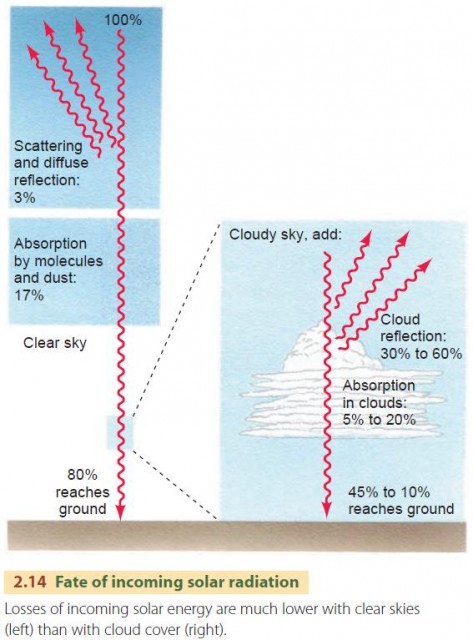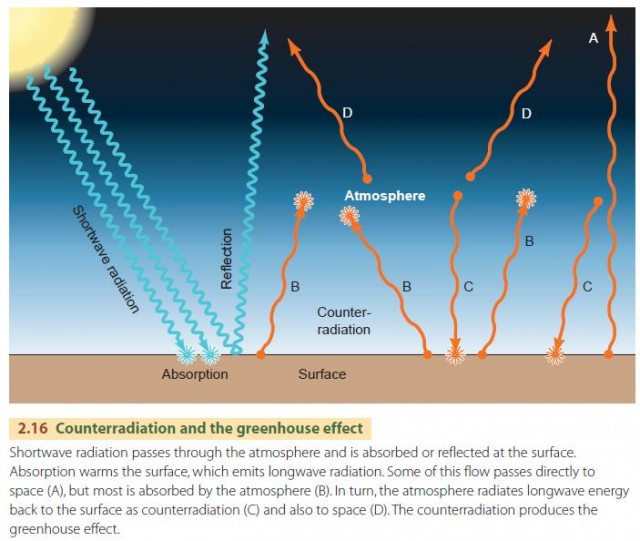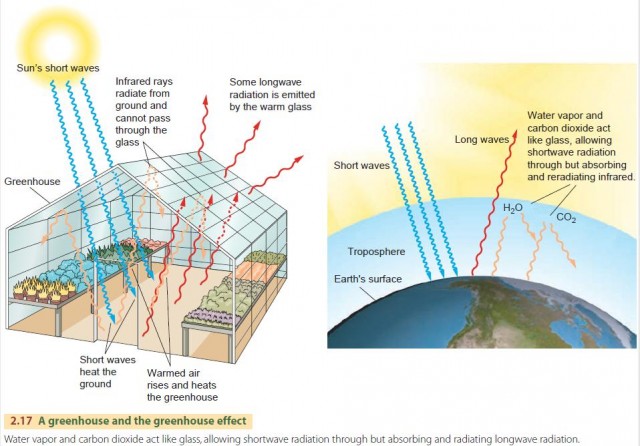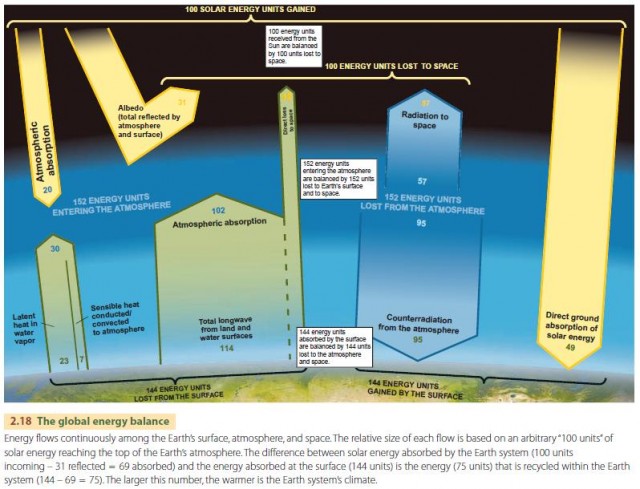The Global Energy System
Human activity around the globe has changed the planet's surface cover and added carbon dioxide to the atmosphere. Have we irrevocably shifted the balance of energy flows? Is our Earth absorbing more solar energy and becoming warmer? Or is it absorbing less and becoming cooler? If we want to understand human impact on the Earth–atmosphere system, then we need to examine the global energy balance in detail.
The flow of energy from the Sun to the Earth and then back out into space is a complex system. Solar energy is the ultimate power source for the Earth's surface processes, so when we trace the energy flows between the Sun, surface, and atmosphere, we are really studying how these processes are driven.
SOLAR ENERGY LOSSES IN THE ATMOSPHERE
Let's examine the flow of insolation through the atmosphere on its way to the surface. Figure 2.14 gives typical values for losses of incoming shortwave radiation in the solar beam as it penetrates the atmosphere. Gamma rays and X rays from the Sun are almost completely absorbed by the thin outer layers of the atmosphere, while much of the ultraviolet radiation is also absorbed, particularly by ozone.

As the radiation moves deeper through denser layers of the atmosphere, it can be scattered by gas molecules, dust, or other particles in the air, deflecting it in any direction. Apart from this change in direction, it is unchanged. Scattered radiation moving in all directions through the atmosphere is known as diffuse radiation. Some scattered radiation flows down to the Earth's surface, while some flows upward. This upward flow of diffuse radiation escaping back to space, also known as diffuse reflection, amounts to about 3 percent of incoming solar radiation.
What about absorption? As we saw earlier, molecules and particles can absorb radiation as it passes through the atmosphere. Carbon dioxide and water are the biggest absorbers, but because the water vapor content of air can vary greatly, absorption also varies from one global environment to another. About 17 percent of incoming solar radiation is absorbed, raising the temperature of atmospheric layers. After taking into account absorption and scattering, about 80 percent of the incoming solar radiation reaches the ground.
Clouds can greatly increase the amount of incoming solar radiation reflected back to space. Reflection from the bright white surfaces of thick low clouds deflects about 30 to 60 percent of incoming radiation back into space. Clouds also absorb as much as 5 to 20 percent of the radiation.
When accounting for both cloudy skies and clear skies on a global scale, only about 50 percent of the total insolation at the top of the atmosphere reaches the surface. When this energy strikes the surface, it can be either absorbed or scattered upward. Absorption heats the surface, raising the surface temperature. The scattered radiation reenters the atmosphere, and much of it passes through, directly to space.
ALBEDO
The proportion of shortwave radiant energy scattered upward by a surface is called its albedo. Snow and ice have high albedos (0.45 to 0.85), reflecting most of the solar radiation that hits them and absorbing only a small amount. In contrast, a black pavement, which has a low albedo (0.03), absorbs nearly all the incoming solar energy. Water also has a low albedo (0.02), unless the Sun illuminates it at a low angle, producing Sun glint. The energy absorbed by a surface warms the air immediately above it by conduction and convection, so surface temperatures are warmer over low-albedo than over high-albedo surfaces. Fields, forests, and bare ground have intermediate albedos, ranging from 0.03 to 0.25.
The Earth and atmosphere system, taken as a whole, has an albedo of between 0.29 and 0.34. This means that our planet sends back to space slightly less than one-third of the solar radiation it receives. It also means that our planet absorbs slightly more than two-thirds of the solar radiation it receives. This balance between reflected and absorbed solar radiation is what determines the overall temperature of Earth.
COUNTERRADIATION AND THE GREENHOUSE EFFECT
As well as being warmed by shortwave radiation from the Sun, the Earth's surface is significantly heated by the longwave radiation emitted by the atmosphere and absorbed by the ground. Let's look at this in more detail. Figure 2.16 shows the energy flows between the surface, atmosphere, and space. On the left we can see the flow of shortwave radiation from the Sun to the surface. Some of this radiation is reflected back to space, but much is absorbed, warming the surface.

Meanwhile, the Earth's surface emits longwave radiation upwards. Some of this radiation escapes directly to space, while the remainder is absorbed by the atmosphere.
What about longwave radiation emitted by the atmosphere? Although the atmosphere is colder than the surface, it also emits longwave radiation, which is emitted in all directions, and so some radiates upward to space while the remainder radiates downward toward the Earth's surface. We call this downward flow counterradiation. It replaces some of the heat emitted by the surface.
Counterradiation depends strongly on the presence of carbon dioxide and water vapor in the atmosphere. Remember that much of the longwave radiation emitted upward from the Earth's surface is absorbed by these two gases. This absorbed energy raises the temperature of the atmosphere, causing it to emit more counterradiation. So, the lower atmosphere, with its longwave-absorbing gases, acts like a blanket that traps heat underneath it. Cloud layers, which are composed of tiny water droplets, are even more important than carbon dioxide and water vapor in producing a blanketing effect because liquid water is also a strong absorber of longwave radiation.
This mechanism, in which the atmosphere traps longwave radiation and returns it to the surface through counterradiation is termed the greenhouse effect (Figure 2.17). Unfortunately, the term greenhouse is not quite accurate. Like the atmosphere, the window glass in a greenhouse is transparent to solar shortwave radiation while absorbing and reradiating longwave radiation. But a greenhouse is warmed mainly by keeping the warm air inside the greenhouse from mixing with the outside air, not by counterradiation from the glass.

GLOBAL ENERGY BUDGETS OF THE ATMOSPHERE AND SURFACE
Although energy may change its form from shortwave to longwave radiation or to sensible heat or latent heat, it cannot be created or destroyed. Like a household budget of income and expenses, the energy flows between the Sun and the Earth's atmosphere and surface must balance over the long term. The global energy budget shown in Figure 2.18 takes into account all the important energy flows and helps us to understand how changes in these flows might affect the Earth's climate. It uses a scale in which the amount of incoming solar radiation is represented as 100 units.

Let's look first at the top of the atmosphere, where we see the balance for the Earth–atmosphere system as a whole. Incoming solar radiation (100 units) is balanced by exiting shortwave reflection from the Earth's surface and atmosphere and outgoing longwave radiation coming from the atmosphere and surface.
The atmosphere's budget is also balanced, since it receives 152 units and loses 152 units. Received energy includes absorbed incoming solar radiation, absorbed longwave radiation from the surface, and latent and sensible heat transfer from the surface. The atmosphere loses longwave energy by radiation to space and counterradiation to the surface.
The surface receives 144 units and loses 144 units. Incoming energy consists of direct solar radiation absorbed at the surface and longwave radiation from the atmosphere. Exiting energy includes latent and sensible heat transfer to the atmosphere and longwave radiation to the atmosphere and space.
The greenhouse effect is readily visible in the two largest arrows in the center of the figure. The surface loses 102 units of longwave energy, but receives 95 units of counterradiation from the atmosphere. These flows amount to a loop that traps and returns most of the heat radiation leaving the surface, keeping surface temperatures warm.
CLIMATE AND GLOBAL CHANGE
The global energy budget helps us understand how global change might affect the Earth's climate. For example, suppose that clearing forests for agriculture and turning agricultural lands into urban and suburban areas decreases surface albedo. In that case, more energy would be absorbed by the ground, raising its temperature. That, in turn, would increase the flow of surface longwave radiation to the atmosphere, which would be absorbed and would then boost counterradiation. The total effect would probably be to amplify warming through the greenhouse effect.
What if industrial aerosols cause more low, thick clouds to form? Low clouds increase shortwave reflection back to space, causing the Earth's surface and atmosphere to cool. What about increasing condensation trails from jet aircraft? These could cause more high, thin clouds, which absorb more longwave energy and make the atmosphere warmer, boosting counterradiation and increasing the greenhouse effect. The energy flow linkages between the Sun, surface, atmosphere, and space are critical components of our climate system, and human activities can modify these flows significantly.